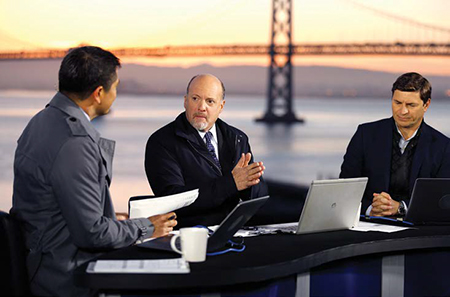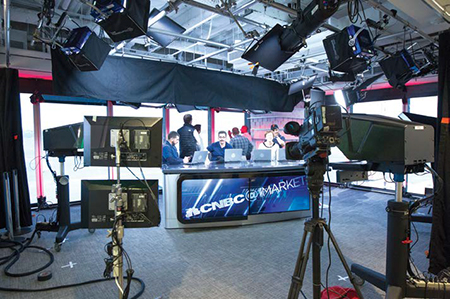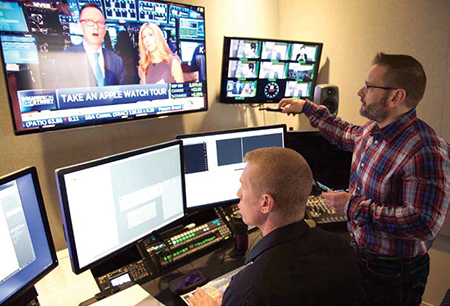Getting Creative With Light

CNBC uses the combined natural and manmade beauty of the San Francisco skyline to provide a backdrop to its “Squawk on the Street” daily program.
SAN FRANCISCO—Curse that light.
It wasn’t the technology, or the infrastructure or the rabidly competitive real estate market that was flummoxing the engineers and producers building a brand new broadcast facility in downtown San Francisco.
It was the light. Milky and murky, sometimes filtered by thick grey fog, sometimes glinting straight through the window, the developers of the new CNBC broadcast facility struggled with that ever-changing light as they worked to build a new broadcast facility in downtown San Francisco.
Built to serve as the network’s West Coast technology bureau, the newly built CNBC@1Market facility finally found its ideal location. Now it had to solve two challenges: ensuring that this facility could be up and running in the wee morning hours when most West Coasters are still in bed. And that the devilish lighting caused by San Francisco’s microclimate could be slayed.
“We needed to find the best space in San Francisco, something with a beautiful view that was easily accessible,” said Steven Fastook, senior vice president of technical and commercial operations for CNBC in Englewood Cliffs, N.J. The resultant 8,000-squarefoot bureau is situated in a building at the foot of Market Street in the financial district of this city, just steps away from the namesake Ferry Building and the enormous San Francisco Bay.
That’s also where the problems began.
Get the TV Tech Newsletter
The professional video industry's #1 source for news, trends and product and tech information. Sign up below.

The new CNBC studio at CNBC@1Market
The CNBC broadcast day starts at 6 a.m. on the East Coast, and by the time the channel’s tech coverage begins, by about 6 a.m. Pacific, “there’s a huge swing of sun activity,” Fastook said, including a constantly changing mix of streaky sun and glinty reflections directly off the Bay Bridge into the studio.
“The sun is a challenge, the fog is a challenge,” he said. “The biggest challenge is to be able to have the inside studio and outside look good together, to see the talent look good and warm in both places.”
The largest studio—a three-camera space with the bay as a backdrop—includes three Sony BRC-H900 pan-and-tilt cameras with 14:1 lenses, Autocue prompters and lights, lots and lots of lights. The tricky lighting outside was mastered with a mix of lighting and drapery inside.
“[Indoor] lighting was a real saving grace for us,” Fastook said. “We can adjust color temperature on the lights to an intensity that you’d associate [with a certain time of day].” The studio is using ellipsoidal lights from the Italian firm Coemar, Creamsource fill lights from the Australian firm Outsight, and L-5 LED lights from ARRI. Cameras in the large studio were outfitted with a series of natural density filters.
In addition to the fully outfitted studio, a smaller “Flash Studio” was built nearby for breaking news and last-minute interviews. That room includes a Sony BRC-H900 robotic cam, Azzurro camera production system, Tektronix WFM7020 waveform monitor and Tekskil on-camera unit with Autocue’s QMaster software for teleprompting. A 75-inch Samsung plasma HD set is used to showcase live feeds, graphic elements or a taped loop of the bay outside.
The bureau also has access to an outdoor terrace with a view of the San Francisco Ferry Building. Power, fiber and connectivity were built into the outdoor terrace to run lighting and Panasonic P2 cameras.
ONE PIPELINE

The new CNBC facility in San Francisco is using two Avid edit bays running Media Composer and using a GV Stratus. Graphics packages, like those being created by freelance editor Rory Keenan (left) CNBC’s Director of Technical Operations Mario Schettino, are stored locally on Avid ISIS servers.
Behind the scenes, the bureau installed two Avid editing suites with 64 TB of shared ISIS storage. A four-channel Avid AirSpeed server is being used for local playout, with a Grass Valley STRATUS content management system being used to transport content to the CNBC headquarters in Englewood Cliffs. “So if I’m sitting in San Francisco and I need to do an edit and go back to an archive, I’m able to open the STRATUS, search for it and pull it back,” Fastook said.
The Avids have allowed the bureau to ensure the workflow was working as intended, said John Chiala, technical manager for CNBC San Francisco. “We wanted to streamline the way that the bureau operates.”
Technology in the backroom includes a set of Miranda and Wohler routers, Fujitsu transmitters and receivers, a Textronix SPG8000 video signal generator, Miranda Densité frame syncs, and RTS intercoms.
What’s also unique about the bureau, Fastook said, is that everything comes back to headquarters via dual 100 Mbps pipes that pass through NBCU Los Angeles and then on to the East Coast. The network can carry eight HD SDI feeds, data from the Avid editing rooms, remote camera control functionality and intercom connections. “All of that transport comes back to on that same pipeline,” he said. It was designed so that everything that is happening in San Francisco can be seen in real time from the network’s headquarters in New Jersey.
“If it’s early or urgent, and I don’t have anyone sitting at the desk in San Francisco, I can turn on all three cameras from here,” Fastook said, the first time that CNBC has engineered a bureau with full studio and camera control. The engineering side—which includes transmission, camera control, diagnostics, and distribution and fiber gear—can be monitored and managed from 3,000 miles away. “I want to be able to see every resource that we have for CNBC in one place,” he said, so that pipeline flow can be monitored and adjusted.
Fastook pointed to CNBC’s cadre of guests and contributors as the reason that the engineering behind the West Coast bureau needed to be as interconnected as possible. To a large extent, IP technology is facilitating that move. “IP technology is a huge enabler,” he said. “It’s changed the capabilities.”
It’s a setup that CNBC may replicate again, as the channel considers installing a similar IP system at CNBC Europe and Asia. “Imagine being able to scan the content library and use it [in other bureaus as needed,]” Fastook said. “It’s working out well.”
Susan Ashworth is the former editor of TV Technology. In addition to her work covering the broadcast television industry, she has served as editor of two housing finance magazines and written about topics as varied as education, radio, chess, music and sports. Outside of her life as a writer, she recently served as president of a local nonprofit organization supporting girls in baseball.

